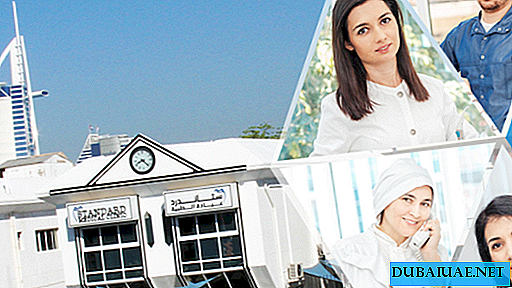Almost everyone goes to the dentist, someone less often, someone more often. Jamshiddin Khasanov, a dentist at Standard Medical Clinic, tells how to go to the dentist properly, according to recent studies recognized as the best dental clinic in the UAE.

I go to the dentist regularly. Unfortunately, dental procedures and examinations are for me not only part of a routine routine that is inscribed on the calendar twice a year, but also a necessity: I, apparently, were not very lucky with genetics - I have dental problems quite often. Like many in Dubai, I prefer to contact "our" doctors: it seems to me that my not quite medical explanations like "it hurts here, but it doesn’t hurt, but pulls" the doctor understands my Russian better.
WITH Jamshiddin Khasanov - a dentist in a well-known city Standard Medical Clinic on Al Wasl road, we talked about how to go to the dentist.

F&K: Doctor, did you have your teeth treated?
Dr. Jamshiddin: Of course! He is still not a dentist who has not been treated for teeth! Although the seal, if everything is done correctly according to the protocol, should last a long time (20 years).
F&K: Can not be! I reworked all the seals that I had since school years, and more than once! What does it mean to do everything according to the protocol? Do I need to ask the doctor for the name of the materials, to note the time of his work?
Dr. Jamshiddin: Of course not. Firstly, all clinics with a good reputation and doctors respecting patients use the same European filling material. There are different materials for children's fillings, there are specifics, and for adults, most doctors have the fillings of the same manufacturer, they are all of high quality. Secondly, the time that the doctor will spend on your seal is difficult to determine - it depends on many factors. Many patients are accustomed, since the old days, probably, to put a seal is a simple manipulation, continuous: drill, close, and that’s all. In fact, I would treat the filling very carefully, because this is most often the first thing we do if the tooth is damaged. And it depends on how accurately the problem is diagnosed, how carefully the treatment is carried out and how the seal is installed, whether we will subsequently be able to save this tooth or not. When planning a visit to the doctor, tune in to a thorough examination and questioning, do not save your time on detailed diagnostics. Especially in Dubai.
F&K: And what is wrong with diagnostics in Dubai?
Dr. Jamshiddin: In Dubai, there is very good technical equipment in many clinics, and there are just diagnostic options. But Dubai is a place of temporary stay for many. Due to frequent travels, people here do not always have the opportunity to be observed by the same doctor who is familiar with the patient’s medical history. For a new doctor, many factors may be hidden, and for effective treatment, first of all, an accurate, comprehensive diagnosis is needed. As well as the patient, in whose interests to receive quality treatment, so that in another place, in another country, he would not have to face the same problem again. About 60-70% of my patients recently have problems with already treated teeth, many of which could have been avoided.
F&K: What, then, does the “correct” diagnosis include?
Dr. Jamshiddin: First of all, it is important to talk with the doctor and outline the problem. To determine the diagnosis, it is not enough to know that the tooth hurts - you need to know how it hurts, that is, the nature of the pain. For example, pain when pressed, pain during a reaction to sweets, night pain - these are all symptoms of various diseases. In addition, the doctor conducts a test external examination. It is important to take an x-ray. I use a Leica microscope at work. Honestly, since the opportunity to work with this device appeared, I have no idea how to do without it.

F&K: How do you use it? Isn't x-ray enough?
Dr. Jamshiddin: In most cases, an x-ray is necessary, but a microscope is indispensable. It allows without any irradiation, with a huge increase, to examine the tooth surface with maximum accuracy and identify defects that are completely invisible during a traditional examination. For example, it can be micro-chips on the border of the established fillings and tooth surfaces: such a tooth can hurt, but when viewed without a microscope and on an x-ray, it looks healthy. Also, the microscope makes it possible to examine the tooth in a vertical plane, which the x-ray does not allow to do. I had a patient with a solid, high-quality filling, but constantly tormenting pain. Only in microscopic images we were able to determine the cause of the pain - there was a vertical split in the tooth under the seal. Without a microscope, it is difficult to accurately assess the condition of the channels under an opened seal, for example.
F&K: With the diagnosis is clear. Does he somehow help in the treatment process?
Dr. Jamshiddin: Of course. I use it all the time. Perhaps this happened to you when the doctor says: we will drill, if we get to the nerve - we will have to clean the canals. So with a microscope, I can more accurately determine whether we get to the nerve or not, and if possible, carry out the procedures as carefully as possible. In addition, detailed microscopic images are filed into the patient’s medical history, and I can return to them during long-term treatment, this is better than relying on memory. Yesterday, for example, a microscope helps me to process the tooth surface with the highest quality for installing a seal: look, with this tool I am drilling at a speed of 300,000 rpm - this is fast work. And this - at a speed of 40,000 rpm - is a slow but accurate job. With a microscope, I can evaluate how thoroughly the surface is prepared and choose the most effective method of treatment.
F&K: Yes, this is jewelry work!
Dr. Jamshiddin: Yes, really, that's what they say about dentists. But first of all, after all, I am a doctor. Our education, fortunately, does not distinguish dentists into a separate category of "aesthetics", like many Western schools. We are primarily specialists with general medical training. Although the dentist needs to constantly undergo training in Western technology today, both in terms of aesthetic dentistry, and in terms of research and technical innovations. Every week something new appears in our field, and many discoveries, like the same microscope, for example, significantly expand the possibilities of treatment.

F&K: Do you advise the patient to choose a doctor or clinic first?
Dr. Jamshiddin: It's a difficult question. The doctor should inspire confidence in you, you should be comfortable in communicating with him - this is definitely very important for treatment. However, the clinic is no less important: the doctor should have a permanent and equipped place of work, individual tools and a planned schedule. A healthy atmosphere in the staff of the medical staff is of great importance: when the doctor has the opportunity to carry out complex treatment with the participation of several specialists, when the work of the doctor and assistant is coordinated. So the advice is this: contact a doctor you trust, who works in a clinic in which he is well.
STANDARD MEDICAL CLINIC provides all types of dental services in Dubai. Complex treatment, care, aesthetic procedures using the latest technologies are carried out by highly qualified Russian-speaking doctors. You can get more detailed information and make an appointment with the clinic on the website www.standardmc.com, call +971 4 328 1112 or at the clinic in Dubai at Umm Suqeim 3Al, Wasl Road, Villa No. 127. For cardholders of the loyalty program "M-Club"10% discount.
The text was prepared by Alla Tverskova.










